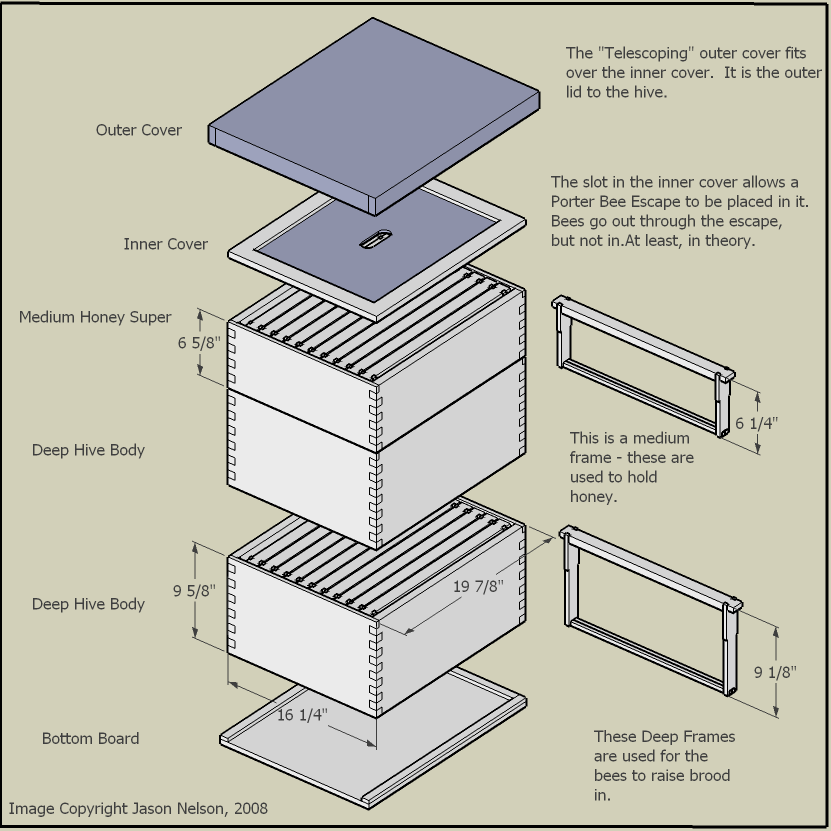Rosetta’s Guide to HivesThe terminology of beekeeping is a combination of English and bad English, of phrases that make grammar Nazis grind their teeth and confound even experienced editors. Since we’ll be talking a lot about bees and hives it helps to have some idea what we are speaking about. You could jump in and keep some bees and learn what all of this is. If so you don’t need this book, you need to watch and learn from your own bees. If you do not have the pleasure of working a hive read on, for this section will serve as a guide to the building blocks of a hive, a roadmap for the images to come. If you prefer to look at pictures, jump to the bottom to analyze the "Anatomy of a Beehive" It’s a Box, JimThe hive is a box. It’s a box with some very particular dimensions but it’s a box none the less. What does tend to vary is the depth of the box and how many of them are needed. When a colony first starts out it is tiny, so it usually has only one box. For a few thousand bees it’s roomy, much like a family of six in a New York apartment. As they grow the beekeeper adds more of these boxes, some of them holding, well, bees, and some to hold honey. More on that later. Comb AloneBees build honeycomb from wax they secrete. These combs are versatile, serving as both storage for honey and pollen and tiny cribs in which to raise baby bees. Combs are not designed to be moved and that creates a problem. To grasp the state of a colony the beekeeper needs to be able to look at the surface of the comb to understand what is or isn’t in there. For this reason beekeepers invented movable wooden frames, a square piece of wood in which the bees are encouraged to draw their comb. This square can be lifted out and inspected keeping the comb intact. The average hive body has ten frames in it. Is it a lid or a cover?It’s both. Some beehives use an inner cover, a thin slat of wood that provides a dead air space above the colony. The inner cover serves as a sort of artificial “top end” for the colony. On top of an inner cover fits a Telescoping outer cover. That’s a fancy phrase for a cover that fits over both the inner cover and the top of the hive body. Another common type of top is the Migratory top. A migratory top dispenses with the inner cover entirely. It is in effect a flat piece of plywood cut to the size of the hive. Crashing boards, landing boards and other boardsWith a box and a lid, some frames to go inside, you need something for all of this to sit on. That’s the bottom board, which is exactly what the name implies – a board that goes on the bottom. This board has sides which lift the hive body slightly off the bottom board. It is this space which forms the entrance to the hive. If the bottom board extends outward past the entrance, that space forms the landing board. Think of the landing board as a sort of runway and dance party combination where bees can land and come in or take off. Excluders and IncludersA queen excluder is a metal mesh spaced so that worker bees can fit through while the queen with her wider thorax cannot. Placed on top of a hive body it is an excluder, preventing the queen from going into the boxes above. Placed at the bottom of a hive it serves as an include, preventing the queen (and drones) from leaving the hive. Using an excluder as an Includer won’t keep the bees from swarming, it will just delay them. If the drones aren’t let out the colony can grow quite agitated. Back to BoxesNot all boxes are created equal. Several “Standard” box sizes dominate the bee hive market, each with different purposes. Deeps, or Deep hive bodies are exactly what their name implies, deep. They’re also heavy, weighing over 100lbs when full of honey. Two deeps stacked together make a respectable colony. To deal with the weight of Deeps there are Mediums, which are just like deeps but not quite as high. Weighing in at 60lbs each these are better on the back. Three Mediums is usually accepted as equivalent to two Deeps. Shallow or Honey Supers. Super in this case means a box put “super” or on top of another box. As the name implies, they are the shallowest of all boxes and weigh only about 35lbs full. No one uses shallows for hive bodies except in emergencies or when the queen decides to lay in them (a condition the queen excluder is meant to prevent). Gadget and GearBeekeepers love gadgets. We have honey knives, heated honey knives, electrical honey knives, vibrating honey knives and several other flavors of long blades designed just to remove the cell caps for harvesting honey. We have extractors which spin the frames like an out of control carnival ride and hurl the honey out for harvest. We have feeders that sit on top of the hives and bottoms you can peak into. For every itch a beekeeper’s ever had there’s three gadgets that scratch it. Each has advantages, all claim to be the best and your mileage _will_ vary as to how useful these things are. Keep your eyes open, some gadgets will be referenced on down the line.
Now that you have a basic view of the hive we can begin to discuss the events that occur inside it. What’s missing so far? The bees. We’ll look at how they arrive next at the Birth of a Package. |
